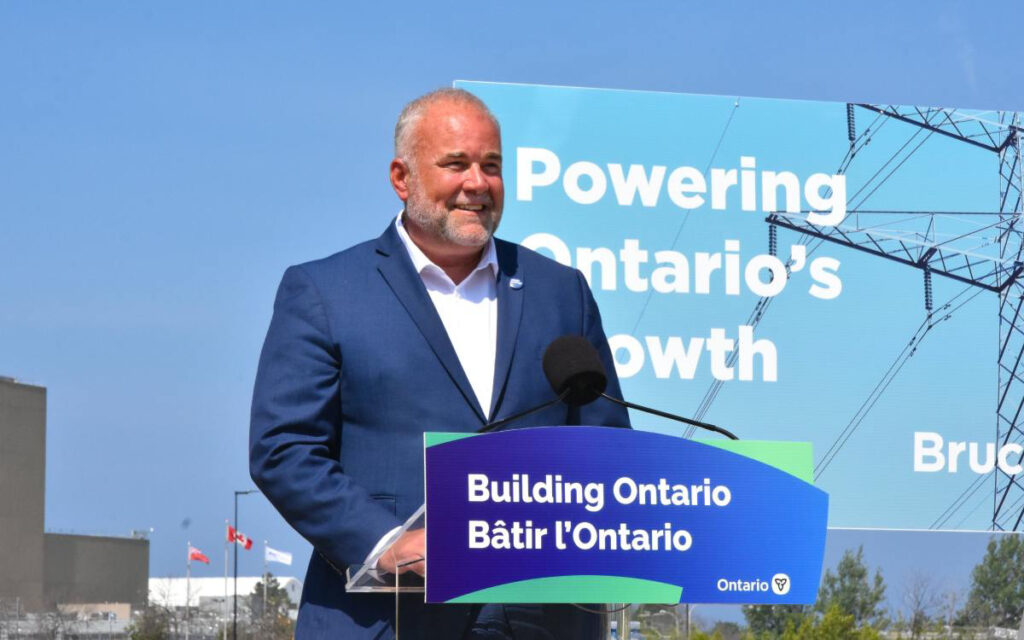
If Ontario wants to be able to meet our future energy needs and reduce greenhouse gas emissions at the same time, then nuclear energy must remain in the mix with natural gas, hydroelectric, wind and solar. Pictured: Ontario Energy Minister Todd Smith. Photo Credit: Twitter/Todd Smith.
What often gets lost in the debate over creating an economy that produces “net zero” greenhouse gas emissions is common sense. But to pretend that our modern, high-tech society can rely on green energy sources for most of our growing electricity needs is not realistic.
Maybe someday, when battery storage capability is much improved. But for today and tomorrow, we need to continue relying on more traditional – and dependable – energy sources to power our homes, our vehicles and our businesses and manufacturers.
Luckily for Ontarians, moves by the current provincial government demonstrate that they understand the challenge.
Late last month, Ontario announced the refurbishment of several units at the Pickering Nuclear Generating Station (PNGS). It is a smart move for several reasons.
First, nuclear power is virtually free of carbon emissions, a so-called greenhouse gas considered by many to contribute to global climate change. Ontario and Canada have promised significant reductions in greenhouse gas emissions to join the international fight to combat climate change.
But in the words of Ontario Finance Minister Peter Bethlenfalvy, “you can’t get to net-zero without nuclear.”
Even this year’s international “COP28” climate summit in Dubai, called for a tripling of global nuclear power capacity by 2050 as a way to help reduce greenhouse gases.
Secondly, Ontario cannot provide enough stable energy to meet the demands of a growing economy without it. Nuclear energy already provides over half of the province’s base load of power. Wind and solar energy, while currently part of the overall mix, can’t hope to meet that much demand in our climate.
Solar requires the sun to shine (which it didn’t for most of January in Ontario). Wind requires the wind to blow (which it failed to do in extreme weather events such as in Alberta and Texas.) And even hydroelectric requires full reservoirs, a challenge in some regions experiencing serious drought. Nuclear on the other hand, does not face any of these issues and keeps generating regardless of weather events.
Thirdly, the nuclear industry provides thousands of high-tech, high-quality, high-paying jobs. In Durham Region alone, home to both the Pickering and Darlington stations, approximately 6,500 jobs are supported.
Fourthly, Canada excels in the nuclear energy world. CANDU reactors, the most dependable, are a Canadian success story, providing safe, dependable power in countries around the world. That in turn, supports a nuclear technology supply chain in Canada which produces some 76,000 high-quality jobs and 240 supply chain companies across the country. The Pickering project will help to continue anchoring this industry in the country.
Critics argue that nuclear plants have been notorious for expensive cost over runs. Energy Minister Todd Smith’s cautious response to the cost questions and his reluctance to provide any hard cost numbers at this point indicate that he knows the risks. Just planning the refurbishment of the 40-year old reactors in Pickering will cost at least two billion dollars.
But Ontario’s recent experience with CANDU refurbishment projects at the Bruce and Darlington plants have proved that it is possible to actually meet realistic budgets and timelines. And despite those costs, nuclear is still Ontario’s second cheapest power source after legacy hydroelectric dams, when all is factored in.
Another overlooked benefit of Ontario’s home-grown nuclear industry is that the Pickering plant, produces Cobalt 60, a medical isotope that is used to sterilize single-use medical devices literally around the world and is also helpful in killing harmful pathogens in many food and consumer products.
No doubt there will be setbacks and controversies over the life of the refurbishment project, providing ample targets for the critics. But if Ontario wants to be able to meet our future energy needs and reduce greenhouse gas emissions at the same time, then nuclear energy must remain in the mix with natural gas, hydroelectric, wind and solar.

Janet Ecker is a former Ontario Finance Minister, Minister of Education, Minister of Community and Social Services and Government House Leader in the governments of Premier Mike Harris and Premier Ernie Eves. After her political career, she served as the founding CEO of the Toronto Financial Services Alliance, a public-private partnership dedicated to building Toronto region into an international financial centre. She currently sits on a number of corporate and non-profit boards, agencies and advisory committees.
Ms. Ecker received the Order of Canada for her public service contributions and was recognized as one of the “Most Influential People in the World’s Financial Centres” by Financial Centres International. She also received a “Canada’s Most Powerful Women: Top 100 Award” from the Women’s Executive Network and the Richard Ivey School of Business, among other awards. She is also one of the founders of Equal Voice, a national, multi-partisan organization working to elect more women.


















